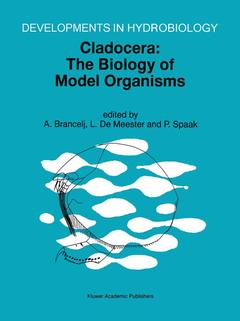Description
Cladocera: the Biology of Model Organisms, 1997
Proceedings of the Fourth International Symposium on Cladocera, held in Postojna, Slovenia, 8-15 August 1996
Coll. Developments in Hydrobiology, Vol. 126
Coordinators: Brancelj A., De Meester L., Spaak P.
Language: French
Subjects for Cladocera: the Biology of Model Organisms:
Publication date: 11-2012
303 p. · 19.5x26 cm · Paperback
303 p. · 19.5x26 cm · Paperback
Description
/li>Contents
/li>Comment
/li>
Cladocerans are increasingly used in many fields of science and this volume covers a wide range of such topics. Cladocerans have a strong influence on freshwater ecosystems and in some aspects they can be used in biomanipulation projects.
Their fast and easy asexual reproduction offers a wide range of possibilities for studies in many fields of research: genetics, ecology, ecotoxicology, etc. In some ways they are the Drosophila of the present day. Their global distribution makes them of special interest from a phylogenetic and biogeographic as well as an ecological point of view.
Apart from the proceedings of previous symposia, there are no other books which cover the whole range of aspects. These proceedings update the last symposia as well as including completely new information on certain fields of research.
Target groups are research scientists within ecology, systematic biology, evolutionary biology and population biology. The book could also be a useful source of information for special courses for students of the above mentioned topics.
Their fast and easy asexual reproduction offers a wide range of possibilities for studies in many fields of research: genetics, ecology, ecotoxicology, etc. In some ways they are the Drosophila of the present day. Their global distribution makes them of special interest from a phylogenetic and biogeographic as well as an ecological point of view.
Apart from the proceedings of previous symposia, there are no other books which cover the whole range of aspects. These proceedings update the last symposia as well as including completely new information on certain fields of research.
Target groups are research scientists within ecology, systematic biology, evolutionary biology and population biology. The book could also be a useful source of information for special courses for students of the above mentioned topics.
Preface. Taxonomy, Systematics and Biogeography. Life History and Ecological Genetics. Behaviour. Trophic Interactions and Community Structure. Invited Contributions: Personal Views on the Future of Cladoceran Research.
Cladocerans are increasingly used in many fields of science and this volume covers a wide range of such topics. Cladocerans have a strong influence on freshwater ecosystems and in some aspects they can be used in biomanipulation projects. Their fast and easy asexual reproduction offers a wide range of possibilities for studies in many fields of research: genetics, ecology, ecotoxicology, etc. In some ways they are the Drosophila of the present day. Their global distribution makes them of special interest from a phylogenetic and biogeographic as well as an ecological point of view. Apart from the proceedings of previous symposia, there are no other books which cover the whole range of aspects. These proceedings update the last symposia as well as including completely new information on cert
© 2024 LAVOISIER S.A.S.




